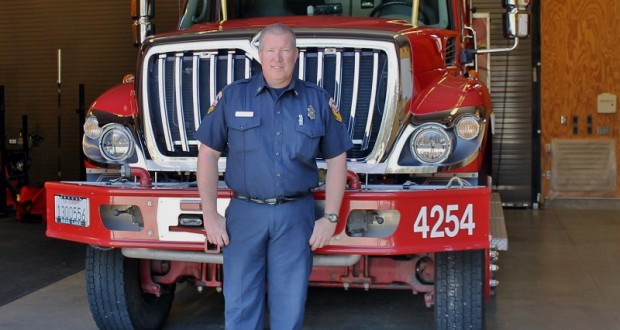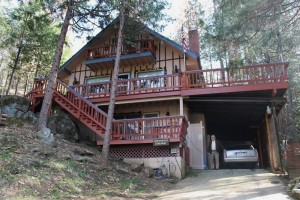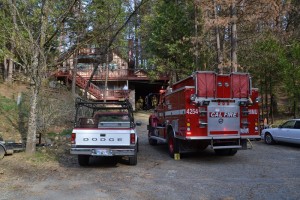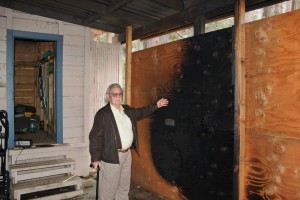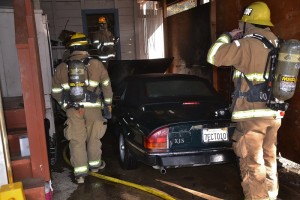Guest Column written by Bill Ritchey —
NORTH FORK – Sitting at the end of the cul-de-sac of Chipo Poyah Road in Teaford Lakes Meadow stands a 3-story house that 87-year-old retiree George Hathaway has called home since 1986. Like other homes in the cozy neighborhood, Hathaway’s sits nestled among dozens of dense pines. Similarly as well, many of his trees have had the life sucked out of them owing to the persistent drought and lethal Bark Beetle.
After two years of disastrous wildland fires in Eastern Madera County, Hathaway hasn’t underestimated the resulting fire hazard posed by the dead trees, and he has so far spent over $15,000 to take them down.
On Feb. 29, however, Hathaway was forced to deal with a fire emergency for which he could have never planned, and which had nothing to do with the Bark Beetle. A disastrous outcome could have resulted that day, if it weren’t for a rarely acknowledged and little-understood relationship between Cal Fire and Madera County known as the “Amador Plan.”
As previously reported in Sierra News Online, a little after 3:10 p.m. on Feb. 29, Hathaway decided to “fire up” the engine of his 1990 Jaguar 12-cylinder convertible, which had been parked for several months in his carport. Telling his story four days later, Hathaway said he turned on the ignition key, and the engine began running rough, and then erupted into a fireball.
A neighbor’s 9-1-1 call was routed to Cal Fire Emergency Command Center in Mariposa, and engines from Bass Lake and Rancheria Cal Fire, as well as Madera County Fire Station 11 from North Fork were alerted to the alarm at 3:16 p.m. Bass Lake Cal Fire Engine 4254 arrived in just seven minutes, at 3:23 p.m.
Staffing Engine 4254 was thirty-two year veteran Fire Captain Mike Hunziker, and Fire Apparatus Engineer Johnny Miller. Hunziker, as “first-in” senior officer, assumed incident command. Owing to years of experience and training, Hunziker gave his initial size-up to Mariposa in a strikingly calm and deliberate tone: “One vehicle, partially involved, in carport. Continue response, will advise.”
As other engines continued their response, Hunziker and Miller initiated fire attack, with the Captain reporting just five minutes later in the same even-keeled manner, “fire contained,” and revised the response to just one additional engine for mop-up.
“In just a few minutes, I looked and they (4254) were here,” said George Hathaway, recalling that day. “I couldn’t believe how fast they got here. I thought I might lose my house.”
Captain Hunziker points how close this incident came to having devastating consequences.
“Flames were starting to spread up the plywood sides of the carport,” sais Hunziker. “We got in there and got a quick knock down. In a few more minutes, we would have had a major structure fire.”
After knocking down of the flames, Hunziker and his crew then had to ensure there was no fire extension into the house structure, and assess Mr. Hathaway to make sure he did not require EMS.
The fire control and minimal property loss achieved in Hathaway’s fire can be explained by a universal theme in the fire service: effectiveness of fire suppression is due to the speed and weight of attack.
As explained in a 2008 report to Madera County Board of Supervisors (doc. 1228495609), “(fire) departments must assemble enough firefighters in a reasonable period in order to control the emergency safely without it escalating to a greater alarm.”
The report, prepared by Citygate and Associates, states that when possible, arrival of fire department personnel should occur within eight minutes from the time of call. This time is critical to avoid the predictable fire behavior known as “flashover,” which is the time when a small fire in a structure instantly engulfs an entire room. When flashover occurs, life is no longer possible, and the fire rapidly spreads throughout the entire structure.
The quick response demonstrated by Cal Fire in this incident was made possible by a rarely mentioned service available to California local government and its citizens known as the “Amador Plan.”
The Amador Plan, authorized by Public Resources Code 4144, allows local government to contract with Cal Fire to provide year-round fire protection services, provided by Cal Fire stations which would normally be closed during the “non-fire” season.
In Madera County, Cal Fire stations at Raymond, Ahwahnee, Bass Lake, and Rancheria are staffed 24/7 during non-fire season on an Amador contract. At each Amador station, Cal Fire funds three personnel, at State expense, at the rank of Fire Captain or Engineer; while Madera County funds two less costly firefighter positions. This ensures a minimum two-person staffing on each engine in an Amador Plan Agreement.
Madera County’s budget for the Amador contract is about $650,000 this fiscal year.
Cal Fire, the common name for the California Department of Forestry and Fire Protection, has been in the spotlight recently for its ability to quickly bring vast resources to bear on wildland fires. With recent years’ local fire disasters, area residents have become accustomed to seeing Cal Fire and its “strike teams” of engines, crews and dozers, and aircraft in action. For over 100 years, Cal Fire’s primary mission has been to manage and protect California forest, range and watershed resources in the State Responsibility Areas (SRA). SRA in Madera County can be explained as those lands east of the Madera Canal, on the valley floor, extending to the Sierra, bordering the National Forest.
Madera County Fire Department, funded by the county’s general fund, serves local government emergencies in the unincorporated areas of the valley floor and Eastern Madera County. Response to emergencies such as structure and vehicle fires, motor vehicle accidents and rescues, medical emergency first-response, and hazardous material spills remain the primary responsibility of local government.
Since the late 1920’s Cal Fire has offered assistance to local government through cooperative fire protection agreements, known as “Schedule A” contracts.
Madera County has the longest-standing contract with Cal Fire in its history of cooperative fire protection. Cal Fire’s contract provides administration and professional staffing of Madera County Fire Department with just 22 personnel at six County stations — Madera Acres, Madera, Bonadelle Ranchos, Rolling Hills, Chukchansi and Oakhurst. Five stations are staffed with only one firefighter, including Station 12 in Oakurst; Chukchansi is staffed with two personnel.
Madera County Fire Department stations in Chowchilla, Yosemite Lakes Park, O’Neals, North Fork, Bass Lake, and Cedar Valley remain staffed exclusively by volunteer/paid-call firefighter (PCF) personnel. Dairyland and Coarsegold stations were closed in recent years due to lack of PCFs. Remaining stations are experiencing an alarming decline in numbers of active PCFs.
According to Battalion Chief Matt Watson, Cal Fire is suggesting that each full-time staffed Madera County Fire station be upgraded to two personnel per engine as one option allowed by a proposed public safety tax. As previously reported, Madera County Board of Supervisors is studying the feasibility of bringing a public safety sales tax measure before Madera County voters.
“Cal Fire requires a minimum of two full-time fire personnel on each new engine it contracts to cover, for safety reasons,” said Watson.
Cal Fire’s charge to Madera County for Schedule A services this year is just over $4 million.
Back in Teaford Meadow, a grateful George Hathaway estimates his fire loss at over $10,000 for his car, and the value of his home which was saved at $280,000.
“I can get over the loss of my car,” Hathaway says. “Most importantly, my two dogs are O.K. The firefighters did a terrific job.”
To read the Fire Plan for Madera-Mariposa-Merced Cal Fire Unit, click http://cdfdata.fire.ca.gov/pub/fireplan/fpupload/fpppdf1554.pdf
https://sierranewsonline.com/county-considers-putting-public-safety-tax-on-the-ballot/
https://sierranewsonline.com/supervisors-move-toward-public-safety-tax-ballot-measure/
https://sierranewsonline.com/madera-county-quietly-loses-a-fire-station/
https://sierranewsonline.com/carport-fire-after-explosion-under-the-hood/
Editor’s note: This is one in a series of articles from Bill Ritchey, who, over the next several months, will be exploring the challenges, current conditions and potential solutions to the issues facing the Madera County Fire Department. Bill is a resident of Raymond. With a Masters of Science degree in Nurse Anesthesia, he has been an anesthesia provider for 21 years, and has worked extensively providing trauma and critical care anesthesia at the regional trauma center in Fresno. He is very involved in advocacy for local emergency services, and helped formulate policy for pre-hospital advanced life support by ambulance personnel and fire department first responders in Madera County. He also served as a first responder trainer for Madera City and County Fire Departments.

